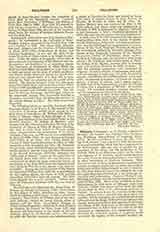

Dillingen, UNIVRSTY OF, in Swabia, a district of Bavaria. Its founder was Cardinal Otto Truchsess von Waldburg, Prince-Bishop of Augsburg (1543-1573). He first established it under the title, “College of St. Jerome”, and endowed it with the revenues of several monasteries which had been suppressed at the Reformation. His aim was to provide for the ducation of the clergy and the protection of the Catholic Faith in an institution which, by the virtue nd diligence of its students, should counterbalance the laxity of morals and insubordination so prevalent in other universities of Southern Germany. With this end in view, he drew up special rules regarding the practice of religion, application to study, and conduct which each student bound himself by oath to observe. In 1551 Pope Julius III raised the college to the rank of a university and conferred on it the privileges enjoyed by other universities. Emperor Charles V ratified these privileges, and the formal inauguration took place May 21, 1554. Some of the professors, as Peter Endavianus, the first rector of Dillingen, came from Louvain; others from Spain, among them the well-known Peter de Soto, O.P., afterwards professor at Oxford. In order to secure the existence of this institution which had been founded with great effort and sacrifice, and to strengthen its intellectual and moral influence on the clergy, Bishop Otto in 1563 gave the Jesuits, whose provincial at that time was Peter Canisius, charge of the instruction in the university, and authorized them to follow their own rules in all that pertained to organization and administration. As, however, the cathedral chapter of Augsburg would not admit the legality of this complete transfer, disputes often arose on questions of right, especially in regard to episcopal visitation, the foundation of chairs of civil law, and the appointment of professors. Nevertheless the chapter paid regularly the sums stipulated in the original document of transfer, and finally accepted the transfer as arranged June 14, 1606, by Bishop Henry von Knoringen (1598-1646), who for that reason is called the second founder of the university. From this date the chapter guaranteed a fixed contribution for the university and convictus (hall for clerical and some lay students). In 1641 Emperor Ferdinand III ratified the new charter in a special document which recognized the great service rendered by the scientific work of the university and by the preparation which it gave young men for their duties toward Church and State. During the Swedish invasion in the Thirty Years War the revenues of the university became less regular, some of-its professors were imprisoned, its students scattered, and the lectures discontinued. But after peace had been concluded the institution gradually recovered, and in 1688 a fine building for university lectures was erected under Bishop John Christopher von Freyberg.
The university’s charter guaranteed to all its members freedom from civil and political obligations, separate jurisdictions, and the right of precedence on public occasions. The exemption from taxes and imposts was frequently disputed by the city council and other officials. The Jesuits, in accordance with the rules of their order, renounced jurisdiction in civil and penal matters. This was exercised by the gubernator, one of the episcopal counsellors well versed in jurisprudence, while matters relating to discipline were in the hands of the rector. The right of precedence at processions and funerals occasioned several bitter feuds between the officials of the episcopal court and the faculty. In 1610 Bishop Henry von Knoringen granted to the rector and the professors of theology the privilege of censorship; in 1747 this was modified to the effect that books printed in Dillingen needed also the approbation of the episcopal censor at Augsburg. The courses which, from the beginning, were given at the university and which were taken over by the Jesuits were humanities, philosophy, and theology. The humanities were taught in the gymnasium, which was at that time a part of the university, and they served as a preparation for the higher studies. In the beginning of the seventeenth century a faculty of jurisprudence was added with one professor of canon and one of civil law. In 1738 church history was included in the curriculum of theology. A department of medicine and surgery, rather loosely connected with the university, was established about the same time.
KARL HOEBER

